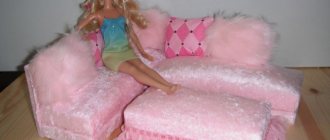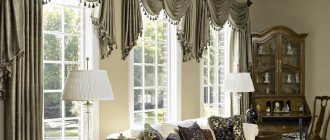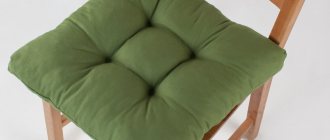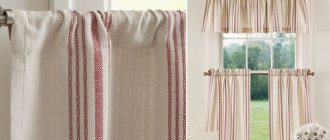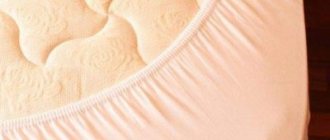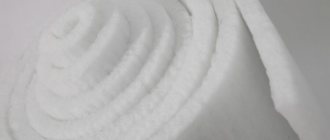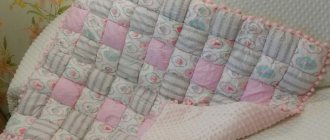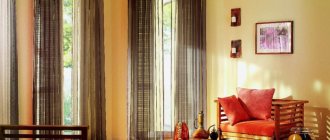The issue of protecting clothes from various types of pollution has worried people since the times of the prosperity of Ancient Egypt. Even then, the first aprons appeared, but they were worn mainly by men. Over their centuries-old history, these products have practically not changed in appearance, except that the methods for creating them have become much more numerous. Today, every housewife knows how to sew an apron of the simplest model without a bib. If you use your imagination, using unusual ideas and original decor, even from unnecessary old things you can create a product that harmoniously combines practicality and beauty.
Apron styles for the kitchen
Many housewives decide to sew aprons with their own hands. The savings in this matter are relative. Home aprons are inexpensive. The main question is interest in the matter, the desire to fantasize, to let your creative streak manifest itself. There is absolutely no need to spend money if there is a suitable thing in the house that has long been unnecessary, which you don’t mind tearing up and sewing a new beautiful apron. When it turns out that there is nothing suitable in the house, they buy the necessary material. Fortunately, the costs are small.
The main thing is to choose a style.
It is practical to have several different aprons in your home. It's expensive to use one. We need a replacement option in case the first one gets dirty. In a friendly family there will be aprons or aprons for the husband and children. A similar thing may be needed in the kitchen, when working in the garden at the dacha, in the garage when repairing a car.
You can purchase it at any store or sew it yourself.
Many girls love to help their mothers cook or come up with their own dishes. They want comfy baby aprons or cute aprons. Boys are interested in tinkering in the garage with their dads. They need to make matching aprons in men's style.
An apron made by yourself will become the most practical thing, as it will be made taking into account all your features.
There are many styles of male and female aprons for home craftswomen to choose from. They can make them for their loved ones so that they are protected from clean clothes getting dirty and quickly wearing out.
It is customary to keep several aprons in the house.
What types of aprons are there for the kitchen? Some aprons are sewn without a top, with fastening at the waist. They are called aprons. Other models have a bib with an additional fastening on the neck. For the first sewing, it is better to choose a simple style with ties at the waist. For experienced needlewomen, it is not difficult to make aprons with various color combinations and finishing with additional details.
There are many styles of women's and men's aprons that perfectly protect clean clothes from dirt, dust, and wear.
How to wear an apron correctly?
Any product requires a certain place and time to be worn. You can't wear an evening dress to the kitchen, or an apron to a dinner party. You also need to know how to properly wear any item, including an apron:
- Models must be selected according to desire and attractiveness. As with clothes, you need to know which product suits the owner.
- Choose an apron of normal sizes (or make it yourself). It should not hang on the person or be uncomfortable.
- An attractive apron should highlight your figure.
Aprons have deservedly conquered all areas of our lives.
A homemade apron can be a beautiful, functional item. With a little effort and creativity, an attractive product will delight the owner of the house.
Which materials are best suited for making aprons?
For one-time use, the apron can be made from any material.
In an apron you can not only feel comfortable, but also work comfortably.
If the product is intended to be used for a long time, the following materials are used:
For a self-made apron to turn out very “successful”, you should choose its style in advance.
A simple apron pattern for a child 5-7 years old
For a girl, the opportunity to cook in the kitchen with her mother is not just work, but a kind of status acquisition. She becomes a real adult hostess. And, of course, such work requires appropriate clothing. We invite you to sew a simple but cute apron for your little helper.
For sewing you will need:
- dense fabric of natural composition, linen, cotton are suitable - 0.4 by 0.43 m;
- oilcloth of the same size - optional;
- strip of lace (optional) – 19 cm;
- bias binding – 0.6 m; 0.75 m; 0.75 m; 0.16 m or strips of fabric of similar length, 3 cm wide;
- threads, sewing tools.
Description
The pattern must be constructed according to the proposed drawing.
If desired, you can make a second layer of oilcloth for the apron. In this case, we cut out the second part, put them together (oilcloth at the bottom) and stitch. Next we work as if we were working on one piece.
Using a basting stitch, sew bias tape along three sides of the apron. Attach and, if necessary, trim off excess trim.
If a strip of fabric is used instead of a finished binding, then we make two counter folds on it and iron it.
We also trim the top edge with bias tape or a strip of fabric. If desired, sew in a lace ribbon.
We process the cuts on the sides of the apron, deciding on the required length of the ties. First we fix the parts with pins, then stitch them.
Repeat for the second side.
We hem the open edges of the trims by hand or by machine, tucking them inward.
Iron the finished product.
How to make a pattern
The most difficult thing when sewing an apron is forming the pattern. It should match the desired style. It's easy to choose the right option. There are many examples on the Internet describing the procedure for making aprons, taken from Soviet-era magazines. For example, such as “Worker”. Having created a pattern, the main fabric product is made from it using hand or machine sewing.
You can cut the pattern from paper such as whatman paper, wallpaper or a sheet of newspaper.
The process is carried out in stages. The pattern drawing, consisting of several parts, is made on wide-format paper. In real scale, two squares appear (apron and bib) and two or three pockets. You can draw ribbons. One for the bib to throw over the head and two for tying on the belt.
Design options for kitchen interiors and what are they made of?
The most common aprons in the kitchen are:
- ceramic tiles;
- glass;
- mosaics;
- artificial or natural stone;
- MDF or chipboard;
- plastic;
- marble.
Their design can be anything from classic to modern.
The most popular types of lamps are:
- Halogen. They can be mounted, built-in or overhead. Such lamps are mounted in furniture at a certain distance from each other. Their advantages include ergonomics, versatility, and long service life.
- Fluorescent. With their help you can create diffused and slightly dim lighting. These lamps do not heat up and have low power consumption. They are located under wall cabinets.
- LED. This type of lighting is the most common. It is characterized by minimal energy consumption, decorative features, and a wide selection. LED backlight can be multi-colored or monochrome. It is attached with special glue under wall cabinets and diffuses light across the entire working surface.
Instructions for sewing aprons for the kitchen
To ensure that the pockets hold tightly and do not tear from loaded weights, you need to perform several lines when attaching them to the apron.
Important! Aprons with ruffles and frills are easier to sew using starched cotton fabric.
Decor options
The choice here is unlimited, but we should not forget that, first of all, the apron performs a practical function. Decorations should be securely attached, not interfere with work, and not make washing difficult. The most commonly used solutions are:
- combination of different types of fabrics;
- ruffles and flounces;
- lace;
- braid and ribbons;
- original shapes of pockets in the form of stars, flowers or hearts.
For men's aprons, the following are more suitable:
- all kinds of belts;
- buttons;
- metal fasteners.
Aprons for children have a wide variety of decor. They do not use them for their intended purpose, so the following will be relevant for decoration:
- rhinestones;
- beads;
- bright applications.
Aprons for girls are very elegant, decorated with bows, inserts made of various fabrics, with patterns made with decorative stitching or acrylic paints. Embroidery or applique is used on plain products. On the bibs of children's aprons you can find funny animals or characters from famous and favorite cartoons.
Decorated aprons require delicate care, so it is better to wash them by hand so as not to damage the decorations.
In fact, sewing an apron is quite simple. You can get ideas and patterns from numerous thematic resources. If you have them, in just a couple of hours you can create a wonderful gift for your mother or grandmother with your own hands, which will always come in handy around the house.
Aprons with applique
Most housewives who have children like to decorate a product with appliqué. For girls, pictures with flowers, butterflies, various animals and birds are selected. The main material is chosen in a light color. Often white or beige. So that the application stands out well.
You can get ideas for sewing and get acquainted with patterns of “interesting” aprons in this article.
For boys, images of construction tools, airplanes, boats, and so on are sewn onto aprons. There are common themes. For themselves, housewives can also be happy to try and decorate their apron with a beautiful applique, choosing an attractive picture.
Aprons decorated with embroidery and pockets always look much more interesting and pleasant than a classic apron.
Material Dimensions
The pattern of an apron for the kitchen is made from a piece of fabric, the size of which is 35-40 by 55-60 centimeters. We will sew the bib from a piece measuring 15 by 25 centimeters, and the pockets from squares 20 by 20 centimeters. It is important to take into account that the dimensions given here are without allowance for processing seams, so when starting to cut the apron, we add another 2-3 centimeters to the original data. It is better to trim the edges with bias tape in a contrasting color. We will sew the belt and strap that hangs around the neck from braid.
Prepare approximately 2.5 meters of material, 3-4 centimeters wide. Wider braid will also look good in the finished kitchen accessory, so choosing the width of the braid depends on your preferences. The dimensions of an apron for a girl are calculated from the knees to the shoulder. Modeling an apron has no restrictions, the main thing is to take into account the points necessary for work.
Shabby chic aprons
The product is sewn from thick cotton fabric in a delicate color. Additionally, they are finished with cotton material with a floral print. This style is called shabby chic. The apron is a one-piece product, where the apron smoothly merges into the bib. Fillet lace is used as finishing.
The apron is secured to the figure by tying it around the neck and waist.
Fabric for chefs' aprons
This element of the uniform must be comfortable, safe, and meet established requirements. Therefore, it is sewn from high-quality calico containing an admixture of polyester. Its main characteristics:
- environmental cleanliness;
- high density, strength;
- resistance to wear and washing powders.
The most suitable fabric for cutting a professional apron should contain 30% cotton threads, approximately 60% polyester. This ratio provides an optimal combination of the advantages of natural and synthetic fibers - breathability, resistance to deformation, hygiene. A prerequisite is a special impregnation that protects against the effects of hot steam, boiling water, and grease stains.
What fabric to make an apron for the kitchen from - beautiful and practical
Home wear items are not subject to such strict requirements as professional uniforms. And the housewife can decide which fabric to choose for the apron herself, guided by her own preferences.
Let's look at the most common options:
- Teflon coated . Most often it is cotton, calico, viscose, artificial materials, the surface of which is covered with a polymer layer. As a result of this treatment, the material becomes waterproof, does not absorb dirt, and reflects heat well, which is its advantage. This item can be safely washed in a machine on any mode. Features: not sold everywhere, has a relatively high cost.
- “Diagonal” is a cotton base with a small addition of synthetics. Special weaving of threads gives the surface an interesting texture. It has high density and elasticity, and is often used to make workwear. Its advantages are strength, thermoregulation, resistance to deformation. At the same time, it is pleasant to the touch, does not irritate the skin, and allows air to pass through well.
- Synthetics . Inexpensive, easy to wash, dries quickly, does not require ironing. A housewife may have several such things in her arsenal that can be changed daily.
- Linen . A linen apron has a decorative purpose, since the natural material absorbs dirt that is difficult to wash off, and after washing it shrinks and requires careful ironing. But in terms of aesthetics it is difficult to compete with it. It perfectly complements the interior styles of “Provence”, “country”, “shabby chic”. A real decoration for a hospitable hostess during a gala feast!
Polyethylene aprons
Models of aprons made of polyethylene are the most durable, protecting against the contact of any chemicals or compositions with chemical additives on clothing. They are convenient for cleaning using all kinds of household products. In the kitchen they will come in handy when cleaning the stove and sink. Such aprons are sewn in the same way as models made of fabric. You can make a one-piece model for greater strength, or make the look with a sewn bib.
There are a variety of manufacturing and color options available.
For gardening
An old raincoat will make a wonderful apron.
How to do it:
- The sleeves, collar and front are cut off from the jacket.
- Fold the fabric in half.
- Draw the outline of the apron with chalk and cut it off with scissors. If bias tape is not used, allowance is left for folding the edges.
- Finish the edges.
- To sew the ties, cut 50-60 cm of ribbon 4-5 cm wide from the front side of the raincoat (vertically) and 40-45 cm for the top strap through which the head will be inserted.
- Sew the double ribbons together along the edges from the wrong sides and turn them out through the hole left. It is folded and stitched.
- Fix the ties to the apron.
- A pocket or pockets are sewn at the bottom for a cell phone or small items.
Instead of ties, they use old belts or leatherette belts that have lost their original appearance. But with a tight belt, working “bent over” in the garden will probably not be very comfortable.
Apron from other ancient peoples
Speaking about the history of the apron, it should be noted that it was also common among other peoples of antiquity, for example in Western Asia, from where it “migrated” to the Europeans. Thus, in the 19th-18th centuries BC in Mycenae and Crete, men girded themselves with a wide leather belt, with the help of which they fastened an apron around their hips. It was worn in such a way that it fell at an angle in front, while its vertical edge ran obliquely, in the direction “thigh - knee of the other leg.” In this case, the product was decorated with a colored woven pattern.
From the history of the apron, it is known that in the times of Ancient Greece, men had an apron, which they tied around their hips, and on top they wore a large woolen scarf, called “hlena”. Later, the apron began to be tied over the chiton.
Aprons were also an item of men's wardrobe among the Etruscans. They were similar in appearance to Cretan ones, but were worn over a blouse. As for the Romans, their aprons were used by priests, soldiers of certain types of troops that were of an auxiliary nature, and gladiators.
Construction of an apron drawing
We will create the apron drawing for an apron of this type.
Taking measurements.
To build an apron with a breast, you need to take only four measurements:
Waist From
Measured around the body at the waistline, used to determine the length of the belt. To correctly determine your waist level, tie an elastic band around your torso and move around a little. The elastic band itself will lie on the narrowest place of the body, i.e. on the waist.
Hip Circumference About
Measured around the torso through the most protruding points of the buttocks. Used to determine the width of the bottom of the apron.
Breast length Dgr
Measured along the mid-front line from the waist line to the desired height of the apron chest
Product length Di
Used to determine the length of the bottom of the apron. Measured from the waistline down to the desired apron length
As an example, here are the measurements of an eleven-year-old girl:
The construction of the apron will be done on half the figure, so the girth measurements need to be divided in half. As a result of division, you will get half-circumference measurements, which are designated by the capital letter C: half-waist girth - St, half-hip girth - Sat.
Half waist circumference St = From / 2 = 60/2 = 30cm
Half hip circumference Sb = About / 2 = 80 / 2 = 40 cm
Don’t be afraid of its simplicity; later, at the modeling stage, you can change it beyond recognition.
The drawing is constructed on a sheet of paper measuring approximately 50 x 100 cm.
To construct a drawing of an apron, we need the following measurements:
Half hip circumference Sb = 40 cm
Breast length Dgr = 22 cm
Product length Di = 45 cm
Stage 1. Constructing the main lines of the drawing
1.1 Mid-apron line
Draw a vertical line 5-10 cm from the left edge of the paper - this will be the line of the middle of the apron.
1.2. Waist line
Stepping back from the top edge of the paper at a distance slightly greater than the Dgr measurement, draw a horizontal line - this will be the waist line.
The intersection of the middle line and the waist line is marked with a beech T.
In the future, all points located on the waist line will be designated by a letter T with a digital index (T1, T2, T3, etc.)
2 tap. Construction of horizontal levels of the apron drawing
2.1. Bottom line
From point T down along the middle line, set aside the measurement Di and mark point H. Draw a horizontal line through point H - this will be the bottom line.
2.2. Line of the upper part of the apron (chest)
From point T up along the middle line, set aside the Dgr measurement and mark point B. Through point B, draw a horizontal line to the right - this will be the line of the upper part of the apron (chest)
Important! The chest line, waist line and bottom line should be parallel, check that this condition is met.
In the future, all points located on the bottom line will be designated by the letter H with a digital index (H1, H3, ...) and points located on the line of the upper part of the apron by the letter B with a number (B1, B2, ...).
Stage 3. Constructing the width lines of the apron parts
3.1. Apron top width
From point T to the right along the waist line, set aside 10 cm and mark point T2. From point T2 up, draw a vertical line until it intersects with the breast line, at the intersection we mark point B2
Important! Line T2B2 should be parallel to the line of the middle of the apron. Check that this condition is met.
3.2 Width of the bottom of the apron
From point T to the right along the waist line, set aside the measurement Sb and mark point T3. From point T3, draw a vertical line down to the intersection with the bottom line, at the intersection we mark point H3.
Important! Line T3H3 should be parallel to the line of the middle of the apron. Check that this condition is met.
Stage 4. Construction of the apron belt
The belt of our apron is tied at the back of the waist. Consequently, the length of the apron belt will be equal to the measurement From plus some value necessary for tying. From experience I can say that for tying it is enough to design the ends to be 30 cm long each.
From point T to the right along the waist line, we set aside a value equal to the sum of St + 30 cm and mark point T1 - this is the end point of the apron belt.
The width of the belt can be any, and it depends on the features of the model and manufacturing technology. We will take, for example, the finished width of the belt is 3cm.
From point T up along the middle line, set aside 3 cm and mark point P. And from point T1 up, set aside 3 cm, mark point P1. Let's connect points P and P1 with a straight line - this will be the line of the upper edge of the belt.
According to the manufacturing technology, it is assumed that the belt will be double and consist of two identical parts.
Stage 5. Constructing the apron straps
The apron model in question has two straps that are tied at the back of the neck.
How to choose the color of the material?
As for the color scheme, the apron for the kitchen is chosen to match various elements :
- Tabletop. With this design, it is worth giving preference to the same manufacturing materials in color, texture and texture.
- Facade. This option is appropriate when it is necessary to highlight a certain part of the kitchen composition. In this case, the color of the facades and apron should be combined with each other.
- Furniture. This option looks quite original and aesthetically pleasing.
- Flooring. You can make a floor and a backsplash from one collection of ceramic tiles. For this design, you need to choose harmonious plain curtains.
- Walls. This option is appropriate for studio apartments, when it is necessary to allocate a work area and a recreation area. It is best to choose neutral colors that match the overall interior.
- Kitchen color. This is an ideal option if you want to make the room look cohesive and light. Ceramic tiles of standard sizes in warm colors are suitable for classic interiors.
A classic kitchen design is white. It combines harmoniously with wood, metal and plastic. The shape and size of the tiles can be any. The trend this season is to decorate this area with marble in gray shades with characteristic patterns in the form of contrasting veins.
In general, the color of the apron can be anything, from light shades to bright red, purple, blue. The main thing is that it emphasizes the individuality and uniqueness of the room and combines with other colors.
How to choose by headset?
Since the main part of the kitchen space is occupied by the kitchen set, when choosing colors for the apron, you should pay attention to the facades.
Types of kitchen apron
All kitchen aprons are divided into 2 types:
- With a bib, such an apron has 2 parts: the hem, the bib, sewn into a single product.
- Without a bib, it is also called an apron. This type of apron consists of a rectangular piece of fabric with a belt.
Depending on the style of the apron, they are divided into categories:
- Hem based on a semicircle;
- Sundress;
- With tassels, ruffles;
- Asymmetrical cut;
- Straight;
- Knitted;
- From a colored scarf;
- With pockets and inserts.
Appearance in Egypt
As mentioned above, the history of the origin of the apron begins in Ancient Egypt. This can be judged by many images of males that have come down to us. From the early period of this country, men who were in public service used drapery, which can be classified as primitive.
As a rule, it was attached to a special belt, which was a narrow leather strip. It could also be reed stems tied or woven together. This part of the attire was also given great importance by the rulers of Egypt, who used it in ceremonial actions, as evidenced by historical monuments.
Over time, such an apron becomes widespread. It was a fabric cloth, the middle part of which was gathered into folds and covered the body from the front. The remaining part of the flap was wrapped around the body and the free end was secured to the middle part. Moreover, this part had one of three shapes - trapezoid, triangle or fan.
How to sew a men's apron in an hour
This apron is extremely practical in every sense:
- it is sewn quickly, without patterns or markings;
- it is double-sided - if one side gets dirty, you can turn it over to the wrong side;
- minimal consumption of fabric and its low cost - a piece of simple chintz 1x1 meter is enough.
Choose a pattern, of course, at your own discretion, but we advise you to pay attention to the striped print: the spots will not be so noticeable, and it will be easier to draw and cut along the lines

